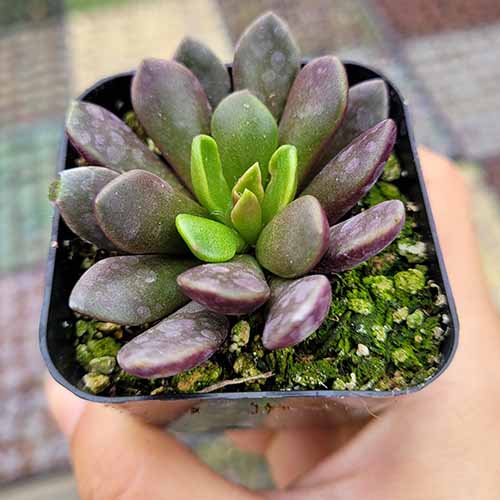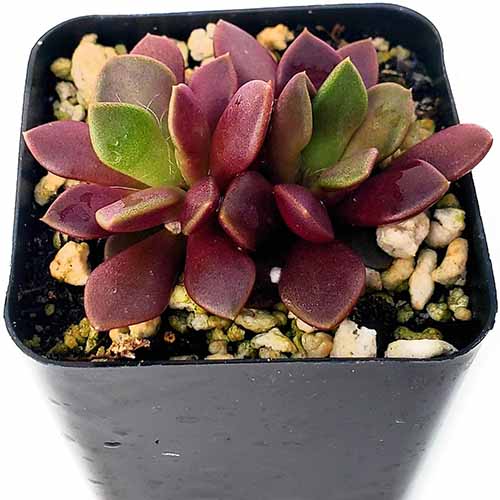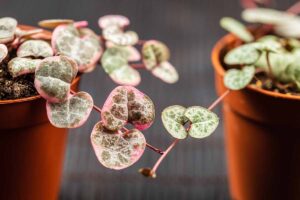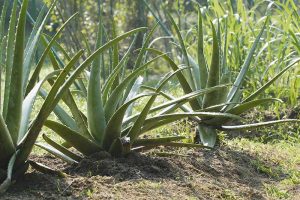Anacampseros spp.
In a world full of cell phone-camera-alarm clocks, slow cooker-air fryer-Instant Pots, and convertible cargo shorts-pants, I appreciate the anacampseros succulent.
This compact plant does one job for us gardeners, and it does it so well. The varieties in this genus are ideal for small spaces, never exceeding six inches tall.

We link to vendors to help you find relevant products. If you buy from one of our links, we may earn a commission.
They may be small, but they have a big impact as day-brightening accent plants, whether you grow them with taller succulents in a dish garden or to create a thick succulent mat along a walkway or at the edge of a garden.
Many varieties sport colorful leaves, while others are attractively coated with downy white filaments or have spritely green foliage.
And these succulents have minimal growing requirements to go along with their compact size.
They’ll thrive as outdoor perennials in USDA Hardiness Zones 9 to 11 and also do well as container succulents in cooler regions.
All they require from a gardener is well-draining soil and plenty of bright, indirect light, or morning sun and afternoon shade outdoors.
In this guide, we’ll go over all the steps to grow and care for anacampseros succulents. Here’s what to expect:
What You’ll Learn
What Is Anacampseros?
Species of Anacampseros will never be the tallest succulents you can find, but they are among the prettiest – and the handiest to use when you need a low-growing filler plant for containers or in the landscape.
Plants in this genus are native to South Africa, and they evolved to develop an ability to store water in their leaves that allows them to tolerate drought.
They still do best with regular supplemental watering, however, especially in the months when they’re actively growing.
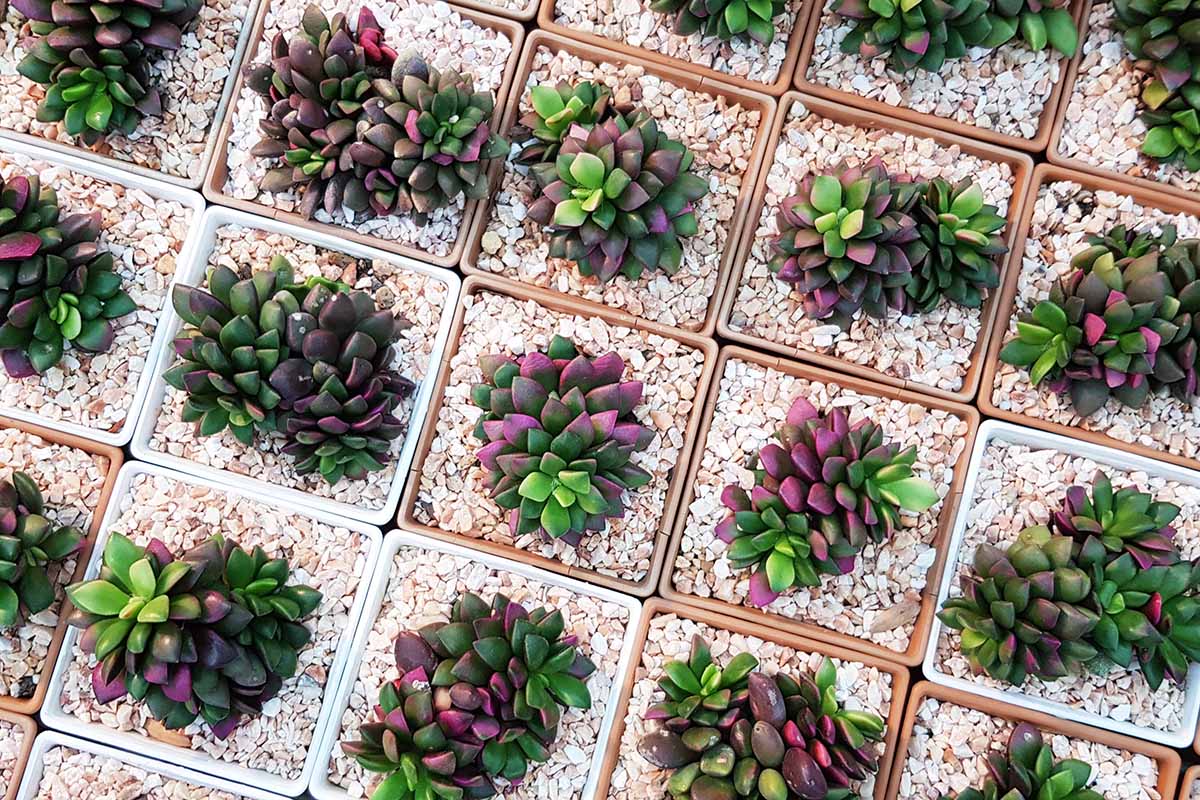
Small undershrubs, they grow in clumps via offsets attached to the plant by a stolon or runner, developing beneath the soil and then emerging on the surface.
A single plant can typically spread a couple of feet, depending on the species. But its height won’t exceed six inches, and some varieties are even shorter than that when fully grown. Their growing season is spring and summer, and they’re dormant in winter.
Those grown outdoors with plenty of light may bloom in summer, though the flowers have the intriguing habit of opening only on sunny days. These are self-pollinating and will form seed pods for propagation.
A bit of background will help you understand the tendency to mislabel this plant. Since 2010, Anacampseros has belonged to the Anacampserotaceae family, but the genus was previously considered part of the Portulacaceae family.
Sedum anacampseros is not to be confused with the plants of this genus – it’s part of the Crassulaceae family.
As a succulent gardener, you’ll never come across most of the species in this genus in cultivation.
The most commonly available are A. rufescens and A. telephiastrum. The former is known as the sand rose and both are referred to as sunrise plants.
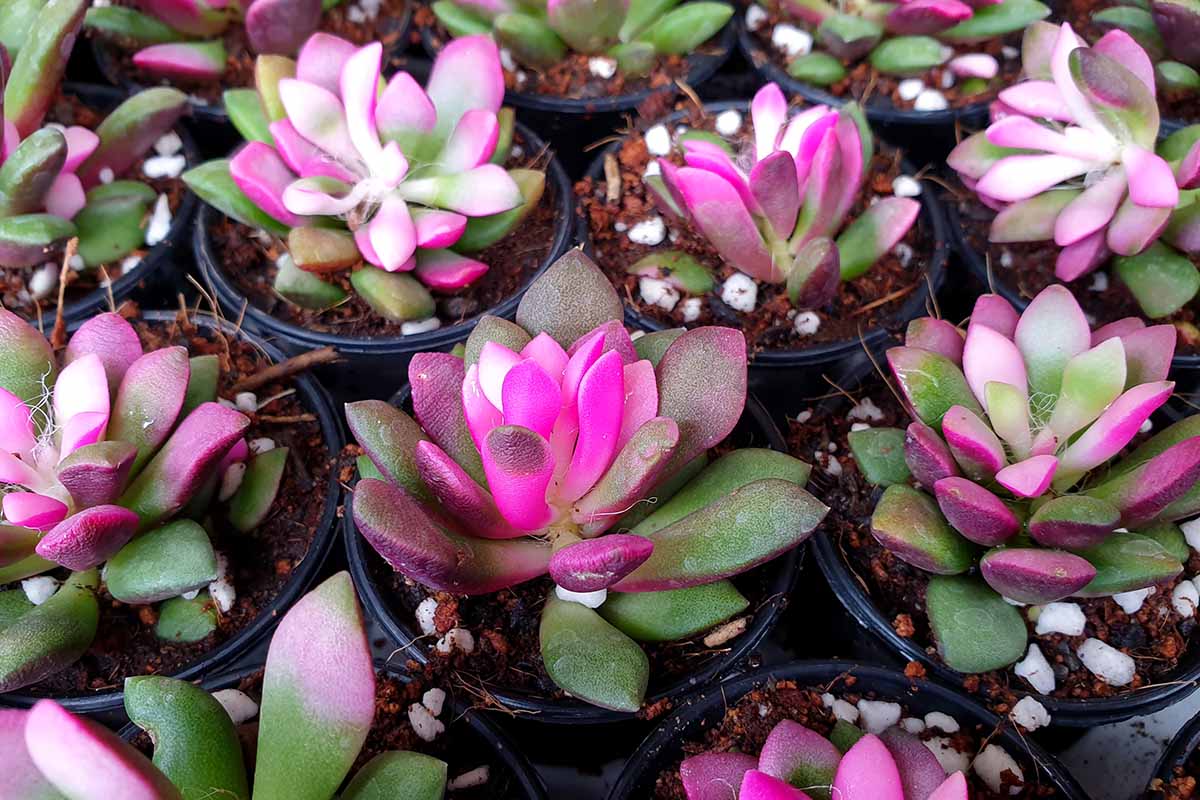
These species sport leaves in a range of gem tones, including purple, magenta, and pink, depending on the variety and whether they receive ample sunlight.
Just a couple of the other notable species include A. arachnoides, which has densely arranged leaves with a coating of what looks like filmy spider webs, and A. albidiflora, which grows just two inches tall and is coated with hairs resembling white cotton candy with bronze tips.
Propagation
If you already have a mature anacampseros, or access to a friend’s plant, offsets or leaf cuttings will yield new plants quickly.
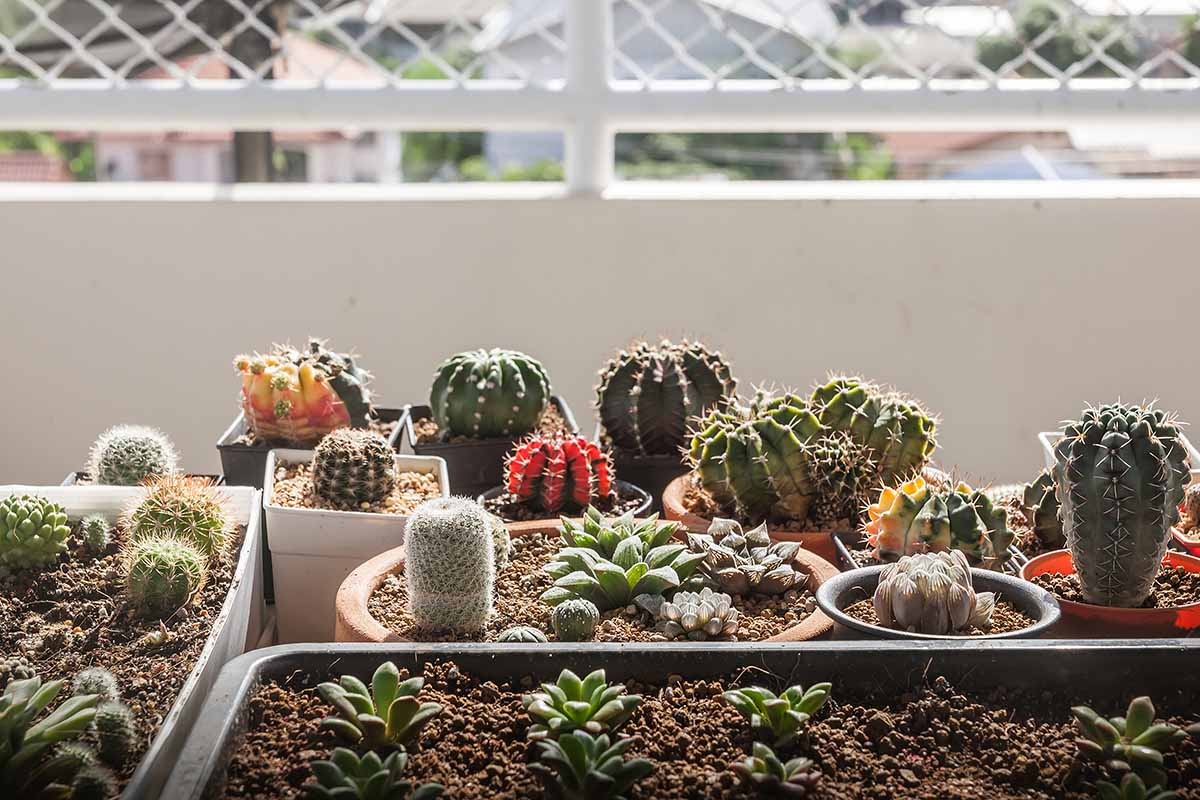
Growing anacampseros from seed isn’t as fast, but you may want to give route a try if you have a seed source. Here are the basics on propagating via each of these methods:
From Leaf Cuttings
To root a leaf cutting, use sterile scissors or a paring knife to cut a healthy leaf where it connects to the stem.
I prefer to take leaves from a plant that is at least a couple of inches tall, so I can take several without hurting its overall appearance and hedge my bets if one or more don’t readily produce roots.
Lay the leaf on a flat, clean surface and wait a couple of days for the scar where you cut it away from the plant to form a callus.
Then, place two to three inches of pre-moistened cactus and succulent growing mix in a shallow container, or in several smaller seed starting cells that are an inch or two wide. Don’t use peat pots as they retain too much water.
Cuttings can also be rooted in the container you plan to keep them in, with no transplanting required later. Use two parts cactus and succulent mix combined with one part each of perlite and sand for the best free-flowing drainage.
Lay the callused leaf cuttings flat on their sides on top of the growing mix, pressing them down gently with your fingertips so the leaves make contact with the surface. Don’t poke the leaves into the soil, though – just rest them on top.
Set the container in bright, indirect light, out of direct sunshine.
Use a spray bottle of water to mist the soil as needed, and keep it lightly moist. Within a few weeks, you should see the leaf shriveling with roots protruding from the end and starting to grow into the soil.
Within a few more weeks, the rooted cutting will send up new leaves.
Once these propagated transplants are half an inch tall, they’re ready to move into their own one- to two-inch pot to grow on, or they may be transplanted outside in appropriate Zones once they reach an inch tall.
From Offsets
Anacampseros plants spread on their own, generating offsets or “pups.” Mature plants grow entire rosettes attached to the parent by a stolon, and these offsets begin branching below the soil surface.
Separating an offset is a quick and simple way to propagate a new anacampseros plant.
It’s easier still if the pup you sever has already started forming roots. If it hasn’t, this propagation method will involve a few extra steps.
You may be able to spot offsets around the base of the plant. Sometimes the plant is so clumped, it’s difficult to tell whether it has grown a new rosette or whether the foliage you see is all part of the parent plant without pulling it out of its pot.
The best time to separate offsets is when you already have the plant out of the pot in readiness for repotting.
If you want to propagate but it’s not time for a bigger pot, it’s okay to pull the plant out of its container, but do this gently and don’t do it often. Those shallow roots may be injured easily.
Prepare containers with succulent mix, amended with extra sand and perlite for excellent drainage.
Ease out the entire plant, gently cradling it with one hand while you use sharp, sterile garden scissors or a paring knife to cut the offsets off, including the stem each one is attached to.
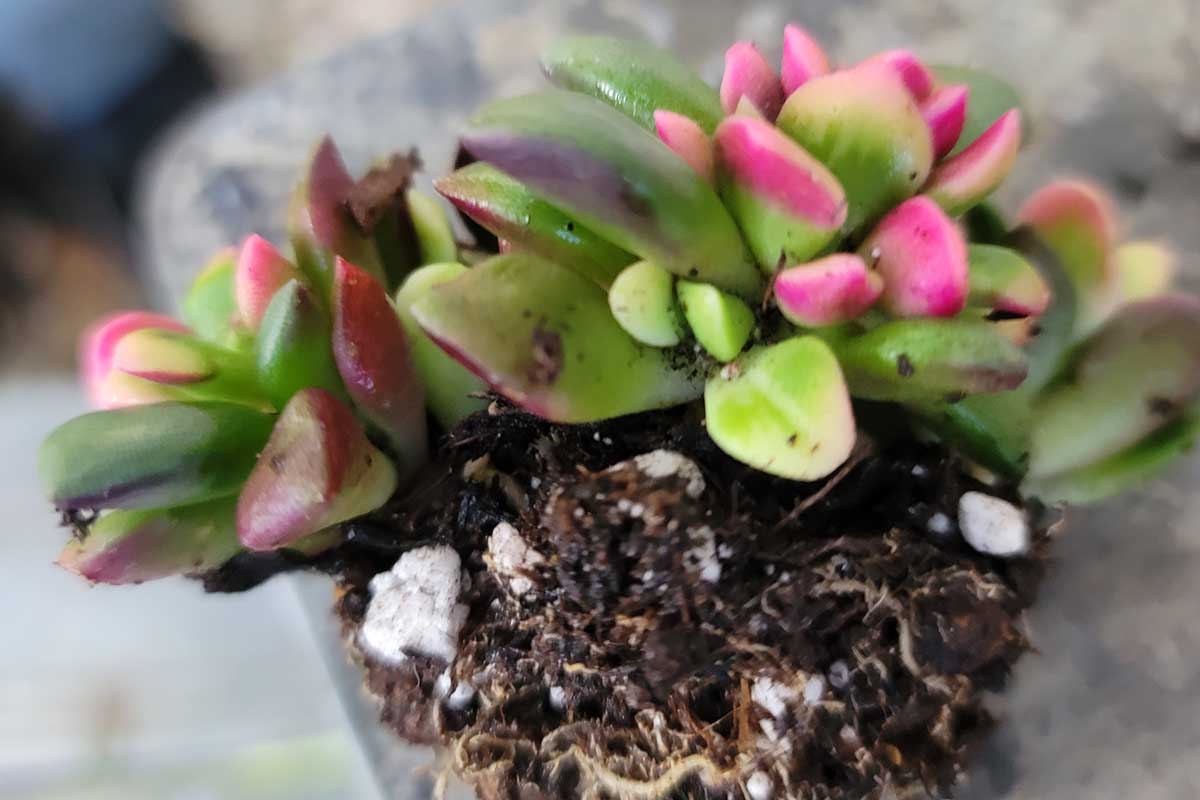
Place the liberated offset directly into a hole you’ve made in the mix in a new pot to contain the roots, with the crown positioned so it’s even with the surface of the succulent growing mix.
Backfill with more soil and tamp lightly with your fingers to secure the roots.
Wait a day or two and then give the new plant a drink of water, letting it drain thoroughly and discarding the excess.
To transplant rooted offsets into the soil of a garden bed or border, cultivate the soil down to at least six inches.
Center each transplant about six inches from the nearest creeping plant, or plant them a couple of inches from the center stem of a taller succulent.
You want to give them room to spread, and you don’t want the other plant to grow to shade your little buddies. But at the same time, you don’t want to provide so much bare soil between the plants that it becomes soggy and causes root rot.
To propagate pups that haven’t had time to develop roots, cut the rosettes and set them aside for a few days. Place them on a clean cloth or paper towel until the moist end where you made the cut has healed and formed a callus.
Fill a container with pre-moistened succulent mix, and place the unrooted offsets on top, with the callus laying gently on top of the soil. Don’t poke it into the soil mix or bury it.
Set it in a location with bright, indirect light exposure. Spritz the soil with water from a spray bottle any time it feels dry to the touch, and look for roots to start forming from the callused end, or possibly from the section of stem that’s still attached, within a couple of weeks.
Find more tips for propagating anacampseros and other succulents in our guide.
From Seeds
While starting anacampseros from seed is not a speedy option, it is possible. First, you’ll need seeds from a reliable supplier or access to outdoor perennials that have flowered recently.
After the flowers wilt, look for seed pods. After the pods dry completely on the plant, remove them and harvest the tiny, white, oval-shaped seeds.
Place the seeds on the surface of a tray filled with an inch or two of a lightly moistened seed-starting medium made up of two parts cactus growing mix combined with one part each of perlite and coarse sand.
You can use any tray you have handy, as long as it’s clean. I like to repurpose fast food salad containers for this purpose since they come with airtight clear plastic lids. It’s most convenient to use a container that’s already divided into separate cells, though.
Place the seeds a couple of inches apart on top of the growing mix, or sow them into separate cells, pressing each one lightly into the mix without putting any soil on top. These seeds need light to germinate.
Use a clean spray bottle of water to dampen the medium just a bit, then cover the tray either with a clear seed starter dome, clear lid, or plastic wrap.
Put the covered tray in a warm place that’s around 70°F, with bright, indirect light for at least four hours per day.
Check daily to make sure the seeds are contained within a moist – but not wet! – environment, and remove the covering to spritz the growing medium as needed. Replace the cover afterward.
Seeds should sprout within five to seven days.
The seedlings will then require another three months of coddling beneath the clear cover, which helps to retain humidity. (I did mention that this isn’t a fast method, didn’t I?) Maintain the same temperature and light conditions, and remove the cover only to spritz the soil when you note it isn’t damp enough.
When the seedlings are three months old, and at least a half-inch tall with at least one set of true leaves, they’re ready to be transplanted into their own one- to two-inch pots.
Don’t try planting them outdoors until they’re at least an inch tall. It’s just too easy for the succulents to be washed away in a rainstorm when they’re that small.
How to Grow
When you propagate or purchase an anacampseros plant, picking a proper site or container and creating favorable growing conditions will set you up for success.
It’s simple to care for these easy-going succulents once the prep work is complete.
Here are the must-haves:
Temperature
Never let these succulents get too cold! They are not frost tolerant, and can only be grown outdoors year-round in Zones 9 to 11.
Those who live in cooler areas must grow them either as full-time houseplants, or in Zones 4 to 9, as outdoor plants that come indoors to overwinter.
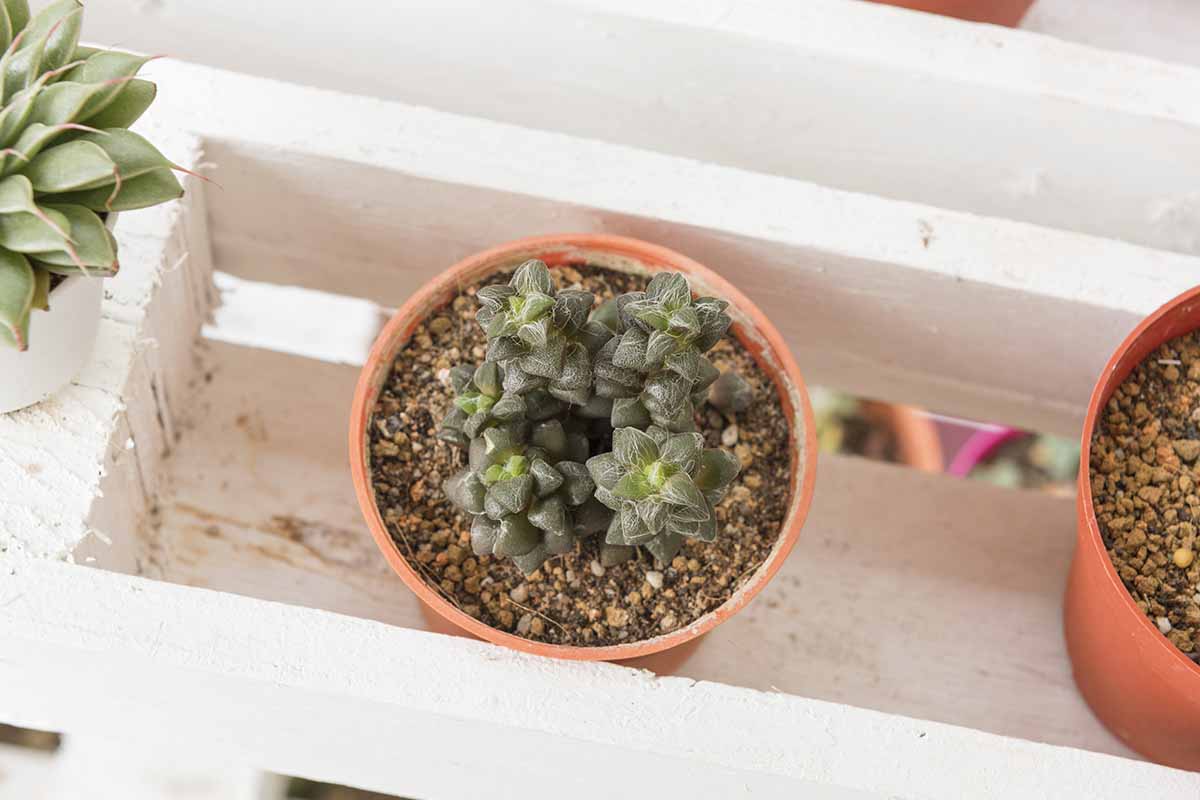
Anacampseros succulents do their growing in spring and summer and will thrive in temperatures from 65 to 80°F, whether inside the average home, or in late spring or early summer weather in many Zones.
Hotter temperatures can curtail their growth, and extreme heat will kill them. So if you live where the weather runs to either extreme, whether hot or cold, plan to grow this succulent as a houseplant in a temperature-controlled environment.
Always protect anacampseros from freezing weather. If you’re growing yours in the ground and a surprise ice storm is heading your way, you may be able to protect it with row covers, or even tarps or sheets.
For container plants, avoid the whole freezing issue by bringing them indoors before temperatures start dipping below 50°F at night. If you forget to make the move and the cold weather sneaks up on you, they may survive a dip to 40°F.
Light
Anacampseros needs ample light, about four hours per day minimum. More light will bring out their vibrant color and variegation in varieties with colorful leaves.
But these plants may also be scorched by strong direct sunlight or harsh afternoon rays. So select a spot outdoors that receives morning sun and afternoon shade. Indoors, opt for a windowsill that receives morning sun or strong, indirect light.
If your household doesn’t have many windows or they’re shaded, consider using grow lights for at least part of the day if you can’t provide enough natural light.
Soil
To grow anacampseros in the ground outdoors, choose a plot with sandy loam that drains quickly or amend the soil to create those conditions. Before transplanting, cultivate the soil to a depth of at least six inches.
If your garden has only heavy or compacted soil, consider growing this ornamental in a raised bed or planter filled with a lighter mix.

Container-grown plants will benefit from a specialty succulent or cactus mix. Avoid commercial mixes with a high percentage of peat, because it tends to hold moisture so well it can threaten anacampseros with soggy roots.
If you live in an area where the humidity regularly exceeds 50 percent, or if you purposely create that condition indoors, consider using potting soil that’s even faster draining. Mix one part each of perlite and sand with two parts cactus potting mix.
Containers
Choose a pot for anacampseros that is porous and well-draining. An unglazed clay pot with drainage holes is ideal, but light plastic pots are fine too, if that’s what the budget allows.
Just steer clear of glazed pots or metal containers without drainage holes.
Also, make sure your chosen container isn’t too big. If it has about an inch of extra space all around its rim, that should allow the plant enough room to spread through offsets but it will still be snug, providing the preferred conditions these plants enjoy.
You’ll also need a drainage tray or saucer to place beneath the container to catch excess water, which you then discard so the plant doesn’t get wet feet.
Water
If you’re prone to overwatering your garden or houseplants, you might want to give anacampseros a pass. These fleshy succulents hold water in their leaves, so they need only moderate amounts of supplemental water.

And it’s not something you can do on a strict schedule. Instead, you should determine whether they need water by evaluating the soil. Use your forefinger or a soil moisture meter to determine if the soil is dry down to at least two inches before watering.
This usually works out to about every two weeks in spring and maybe a little more often in summer, but let the soil’s moisture be your guide, not some arbitrary watering schedule.
For perennial outdoor plants, check how dry the soil is and check the forecast for rain before providing enough supplemental water so the soil is moist but not soggy.
Watering in the morning gives the leaves and stems a chance to dry ahead of nightfall when residual moisture can lead to mildew and mold.
Even with that lead time available, always make sure to water at the soil level, not from above the plants.
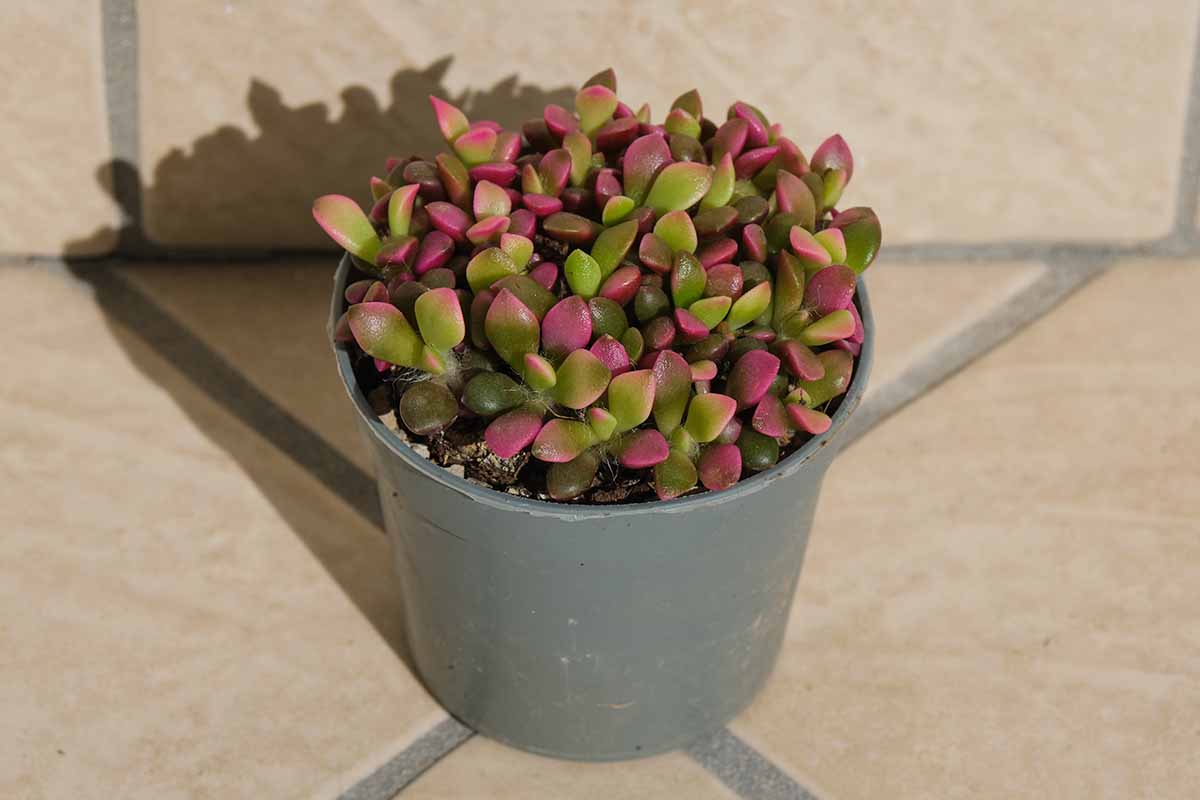
That’s tough with the dense clumps this succulent forms, so just do your best and give the plants plenty of time to dry off as needed at the end of the session.
Houseplant watering cans with a spout that’s easy to direct at the soil line are best.
For indoor plants, add water until you see it draining from the holes at the bottom of the pot. Give it 20 minutes or so to drain completely, and then discard the excess water and replace the drainage saucer beneath the container.
When the plants are dormant in winter they won’t require as much water, and supplementing once a month is usually ample. Again, check that soil to avoid overwatering and causing root rot, which can kill the plant.
Fertilizer
Only give these succulents fertilizer in spring and summer, during their active growth cycle. If you feed during dormancy, you may end up with a leggy plant.
Dilute a liquid succulent fertilizer to half strength, and apply it to already-damp soil once a month.
Growing Tips
- Provide at least four hours of bright light daily so leaves will maintain their striking colors.
- Always plant in well-draining soil.
- Water when the top two inches of soil are dry to the touch, or use a soil moisture meter to check.
- Water less often in winter when plants are dormant.
Maintenance
Maintenance is minimal for anacampseros, whether you’ve planted outdoors in the ground or in a raised bed, or if you are growing them in containers you keep inside or bring indoors for the winter.
They can do without pruning, though you will want to remove any spent flowers in late summer to discourage them from putting energy into producing seeds. (Unless you want to harvest the seeds, of course!)
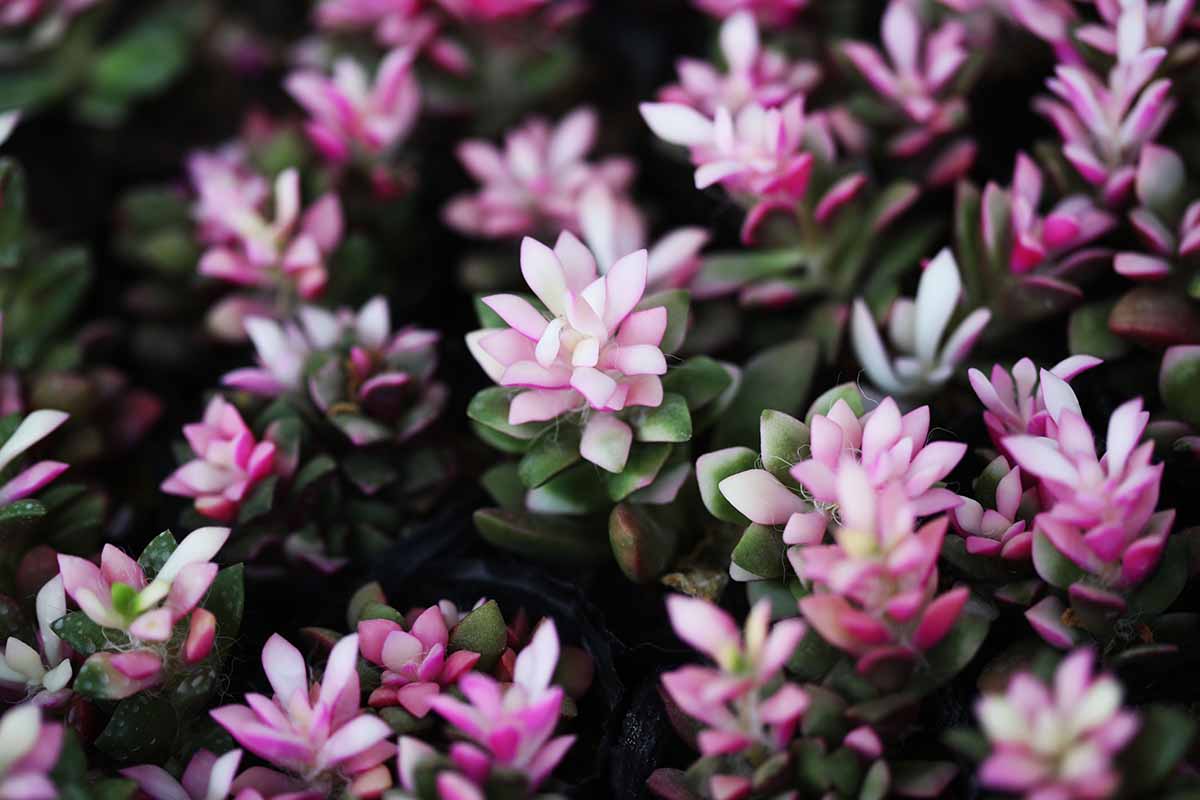
You should also trim away any dead or discolored leaves, being careful to distinguish between light-colored natural variegation and foliage that is sickly.
Again, your aim is to keep any ailments from spreading and also to save the plants from spending valuable energy supporting unattractive growth.
If you are growing your plants outdoors and plan to overwinter them inside, that takes a bit of time and attention. You want to make sure to bring them inside well ahead of chilly weather in late fall. They are not frost tolerant.
I recommend making the transition as soon as nighttime temperatures begin to dip below 50°F, as a standard precaution.
Whether the plants are located indoors or out in the winter months, they’ll be dormant at this time, thus requiring less frequent watering – maybe once a month inside, and only if your area hasn’t received rain in a couple of months if they’re growing outdoors.
Move the plants back outside only after all threat of frost has passed and nighttime temperatures are reliably above 55°F. Make the move gradually so the plants can reacclimate.
Place them outside for an hour or two on the first day, and then increase the amount of time spent outdoors by a couple of hours over subsequent days, until you can leave them outside full-time.
While you don’t want to give anacampseros too much extra space to grow in a pot, you will want to repot your container-grown specimen once every year or two if it’s starting to look cramped in there, or if you can see roots protruding from the drainage hole in the bottom.
The best time to move it to a new home is in the spring, when plants begin their growth cycle anew.
Only move it into a pot that’s a single size larger. Too much space can create a situation where the soil easily becomes too soggy, with extra water that the plant isn’t able to take up through its roots.
These succulents do not like wet feet, and they may succumb to root rot in pots that are too big.
Where to Buy
If only growers and retailers loved anacampseros as much as I do!
This is not one of the better-known succulents, so the varieties that are readily available commercially are generally restricted to A. rufescens, which is commonly called sand rose or sunrise plant, and A. telephiastrum, which also takes the name sunrise plant.
If you spot one of the more unusual varieties at a plant swap, local nursery, or friend’s house, I implore you to snag one – or at least ask for a cutting so you can propagate your own!
When shopping for succulents online, be sure to ask for a heat or cold pack if available when extreme weather is predicted. Or better yet, order only at more temperate times of year to avoid damage in shipment.
Most times, if a plant is labeled or marketed as “anacampseros,” it will be one of these two types. Here are a few selections available for home delivery:
Burgundy
This variegated A. telephiastrum sports a rainbow of leaves that are lime or emerald green, dark pink, and burgundy. The variegation that you see at your place will depend on whether the plant receives ample light.
It will grow to about six inches tall, forming clumps, and spreading via offsets to about two feet diameter if given the space.
Burgundy anacampseros is available in two- or four-inch pots from Succulents Depot via Walmart.
Purple
A purple, generically named anacampseros with emerald and lime green leaves and purple undersides, this variety may develop all-purple leaves when grown in ample light.
The shrubby succulent reaches about six inches tall and can spread a couple of feet through offsets.
It may produce white or pink blooms in summer when grown outdoors. This purple variety is available in 2.5-inch pots from Fatplants via Walmart.
Sand Rose
This A. rufescens specimen has leaves that are muted emerald green. They reach about three-quarters of an inch long and are tightly packed on three- to four-inch stems.
There may be a few wispy white “hairs” growing between the leaves, too. And the undersides of the leaves may turn magenta, or some leaves may develop a purple hue in bright light.
Sand roses ready for transplanting are available in 2.5-inch pots from Bubbleblooms via Walmart.
Managing Pests and Disease
Ordinarily, these succulents are carefree. But it won’t hurt to be on the lookout for these pests and diseases:
Pests
For those fending off certain woodland creatures in the garden, planting anacampseros and other succulents may help.
They’re not what you’d call deer- or rabbit-resistant, but they’re also not a favorite.
If there are other more appealing plants nearby or food in the wild is abundant, you can probably get away with skipping any extra steps to protect your anacampseros from wildlife.
But if you’ve had problems before with other ornamentals being ravaged, make sure to either fence or cover tender younger specimens, especially during times of year when other food is lacking.
Read our guides to learn to build a deer fence or take steps to prohibit rabbits from feasting.
Insect pests are usually not a big deal. Watch out for snails and slugs when your plants are growing in the great outdoors, though.
For houseplants or indoor-outdoor anacampseros, mealybugs can be a threat. You can usually get rid of them with neem oil. Read our guide for more tips on detecting and preventing mealybug infestations.
Scale can also present a problem. These tiny, waxy, white or grime-colored bugs suck sap and can make your plant shrivel and look sickly.
Keep an eye out for scale. If you detect an infestation in the early stages, a cotton ball dampened with rubbing alcohol can usually take care of these pests.
If the bugs are more widespread, you may need to bring out the insecticidal soap or neem oil to combat them. Check out our scale guide for more info.
Diseases
This is where proper watering is key.
Root rot poses the harshest threat to these succulents, but it’s a non-issue if you employ well-draining soil, only water when the top couple of inches of the growing medium is dry to the touch, and never water plants from overhead.
If your plants do develop root rot, characterized by shriveling leaves and dark (and sometimes smelly) roots, the only solution is to trash them, so take these watering cautions seriously!
You may also detect powdery mildew, which looks like a fine dusting of flour on the plants.
Our guide to home and store-bought remedies for powdery mildew on houseplants offers advice on how to cope.
Best Uses
As long as the planting arrangement allows this clumping succulent to receive ample light, it will spread readily as a ground cover, in garden beds, or in borders.
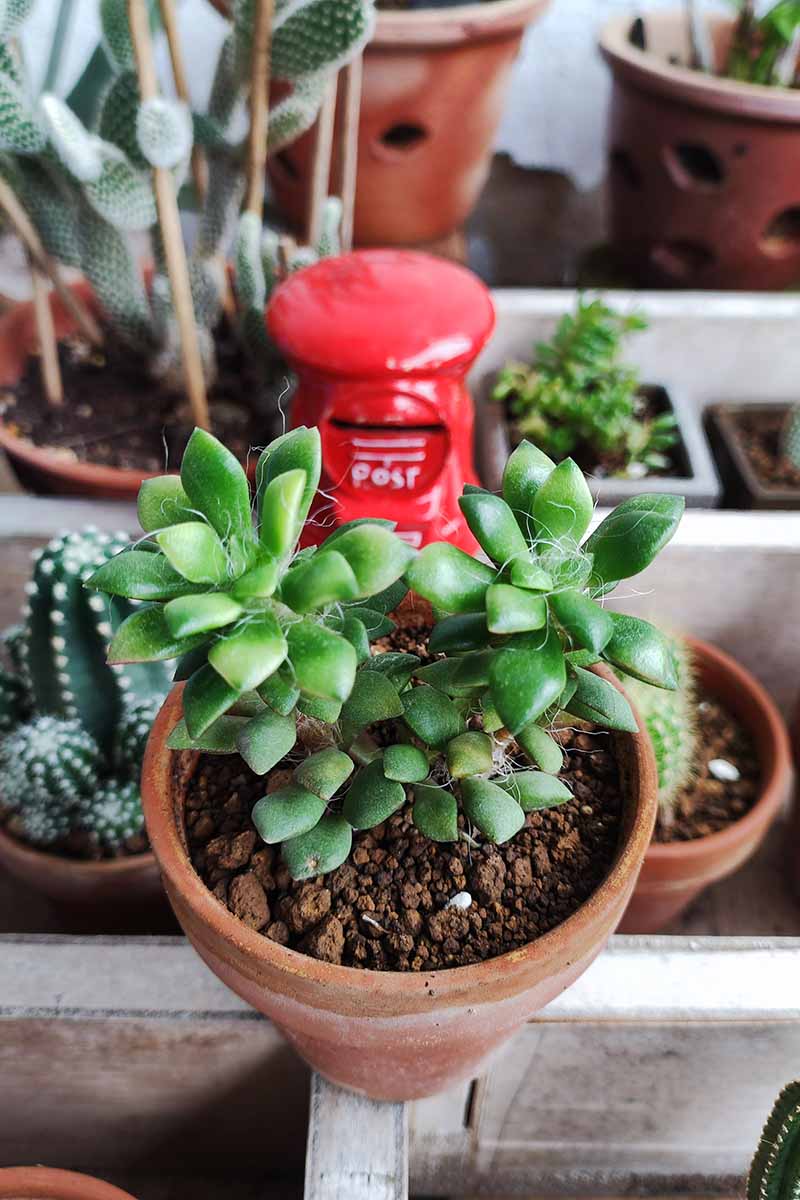
It also makes an easy-care “fill” element below a taller plant in a succulent container garden or window box. I like to grow the pink-leaved sunrise variety alongside a succulent panda plant (Kalanchoe tomentosa), which grows upright.
The silvery, fuzzy foliage of the panda plant complements the bright colors of the sunrise, and while its leaves are larger than those of the anacampseros, they’re not big enough to shade it.
When you grow it in combination with other cacti or succulents, you do have to make sure to remove the offsets regularly so it doesn’t crowd out the other plants, particularly any you intend to allow to trail over the edges of the pot.
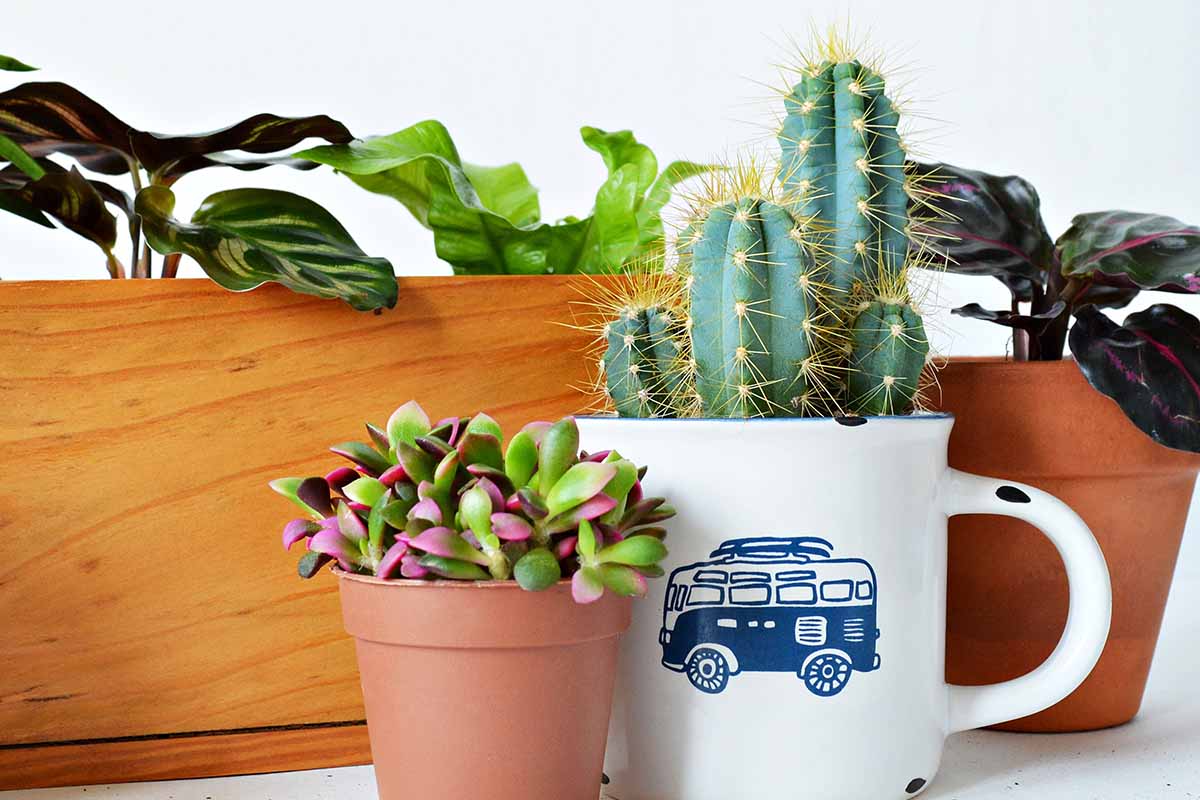
If you’re worried about it spreading too much, you can also grow this succulent in its own container as a houseplant, or transplant a few in a window box where they can spread at will.
Anacampseros offers a striking, compact accent in so many settings, you’ll probably have more ideas available to use it than you have individual plants to start, so make sure to keep up with propagating more for all of your gardening projects!
Quick Reference Growing Guide
| Plant Type: | Flowering succulent | Flower / Foliage Color: | Magenta, orange, pink, purple, red, white/brown, green, green-brown, green-gray, green with white, hairy overcoat, lime green, magenta, pink, purple, reddish brown |
| Native to: | South Africa | Tolerance: | Drought, poor soil |
| Hardiness (USDA Zone): | 9-11 | Soil Type: | Sandy loam (in-ground); succulent or cacti growing mix (containers) |
| Bloom Time: | Summer | Soil pH: | 5.5-6.5 |
| Exposure: | Morning sun and afternoon shade (outdoors); bright, indirect light (indoors or out) | Soil Drainage: | Well-draining |
| Time to Maturity: | 2-5 years | Attracts: | Flying pollinators |
| Spacing: | 8-30 inches | Companion Planting: | Perennials for Zones 9-11 that do well in dry, sunny conditions, like jessamine (outdoors); other succulents and cacti |
| Planting Depth: | Crown at soil surface (offsets and transplants); uncovered on soil surface (seeds) | Avoid Planting With: | Species with high water or low light needs; tall specimens that shade plants |
| Height: | 2-6 inches | Uses: | Beds and borders, ground cover, houseplants, patio containers, rock gardens, window boxes |
| Spread: | 2-24 inches | Order: | Caryophyllales |
| Water Needs: | Low | Family: | Anacampserotaceae |
| Maintenance | Low | Genus: | Anacampseros |
| Common Pests and Diseases: | Deer, mealybugs, rabbits, scale; powdery mildew, root rot | Species: | Albidiflora, albissima, arachnoides, filamentosa, lanceolata, mallei, marlothii, meyeri, namaquensis, nebrownii, nitida, papyracea, paradoxa, parviflora, pisina, prominens, quinaria, recurvata, retusa, rhodesica, rubroviridis, rufescens, ruschii, schoenlandii, scopata, starkiana, subnuda, telephiastrum, tomentosa, truncata, ustulata, vanthielii, variabilis, vespertina, vulcanensis |
Big Color with a Small-Space Succulent
Anacampseros is a small plant with a big personality. Some varieties flaunt a boost of color wherever they’re planted, while others stand out due to the unusual silvery webbing that covers their leaves.
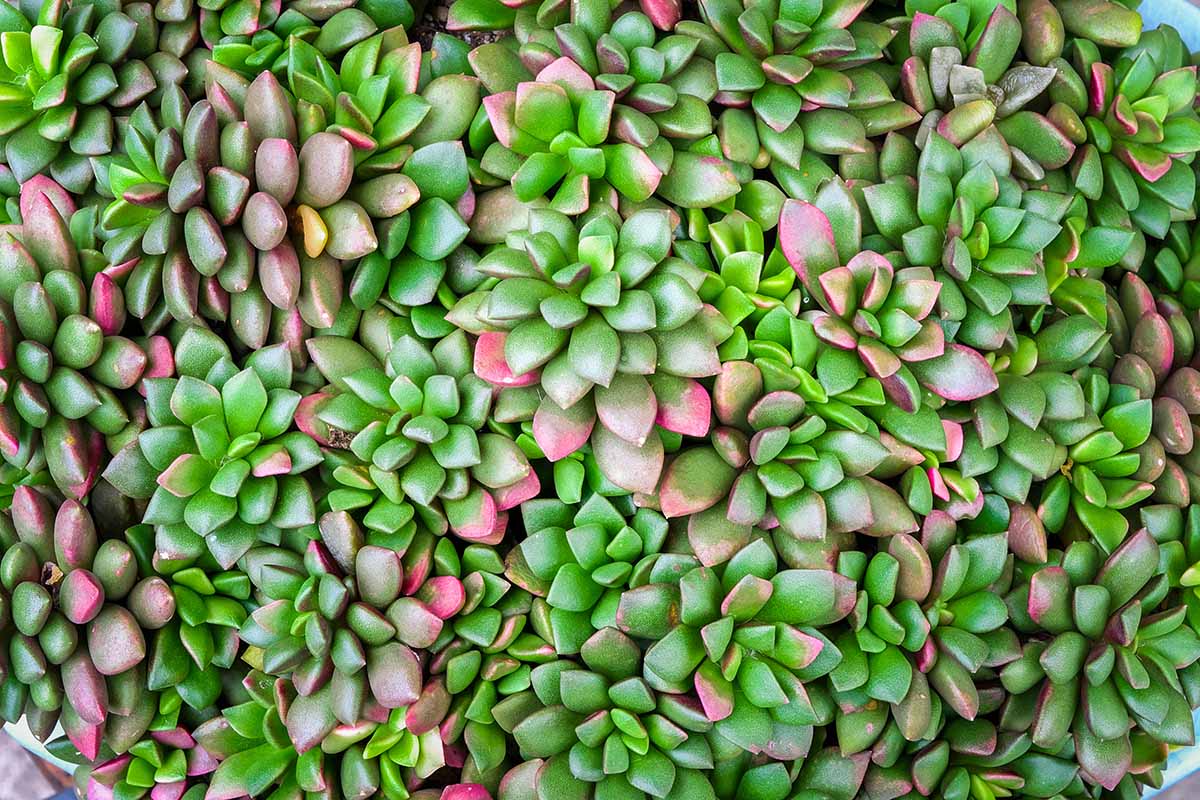
I particularly like to grow mine alongside taller, greener succulents in a dish garden that I bring indoors for the colder months in my Zone 7 garden.
Do you have experience with this diminutive clumping succulent? The comments section below is wide open for you to share experiences or ask questions, so don’t hesitate to join in.
And if you’re looking for more information on other low maintenance succulents, read these guides next:
